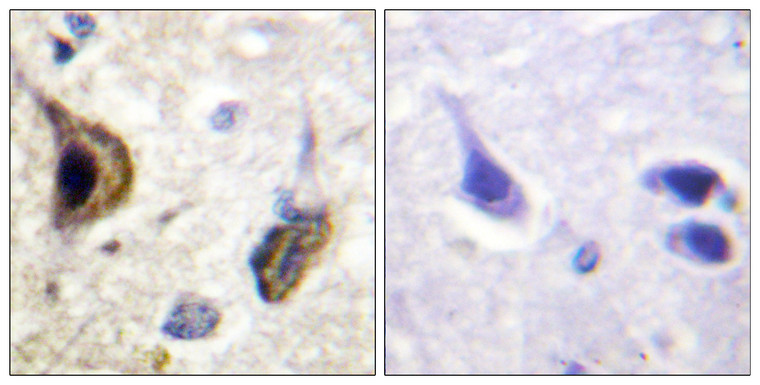| Host: |
Rabbit |
| Applications: |
WB/IHC/IF/ELISA |
| Reactivity: |
Human/Mouse/Rat |
| Note: |
STRICTLY FOR FURTHER SCIENTIFIC RESEARCH USE ONLY (RUO). MUST NOT TO BE USED IN DIAGNOSTIC OR THERAPEUTIC APPLICATIONS. |
| Short Description: |
Rabbit polyclonal antibody anti-Phospho-KCNJ16-Ser416 (369-418 aa) is suitable for use in Western Blot, Immunohistochemistry, Immunofluorescence and ELISA research applications. |
| Clonality: |
Polyclonal |
| Conjugation: |
Unconjugated |
| Isotype: |
IgG |
| Formulation: |
Liquid in PBS containing 50% Glycerol, 0.5% BSA and 0.02% Sodium Azide. |
| Purification: |
The antibody was affinity-purified from rabbit antiserum by affinity-chromatography using epitope-specific immunogen. |
| Concentration: |
1 mg/mL |
| Dilution Range: |
WB 1:500-1:2000IHC 1:100-1:300IF 1:200-1:1000ELISA 1:5000 |
| Storage Instruction: |
Store at-20°C for up to 1 year from the date of receipt, and avoid repeat freeze-thaw cycles. |
| Immunogen Region: |
369-418 aa |
| Specificity: |
Phospho-KIR5.1 (S416) Polyclonal Antibody detects endogenous levels of KIR5.1 protein only when phosphorylated at S416. |
| Immunogen: |
The antiserum was produced against synthesized peptide derived from mouse Kir5.1 around the phosphorylation site of Ser417 at the amino acid range 369-418 |
| Function | Inward rectifier potassium channels are characterized by a greater tendency to allow potassium to flow into the cell rather than out of it. Their voltage dependence is regulated by the concentration of extracellular potassium.as external potassium is raised, the voltage range of the channel opening shifts to more positive voltages. The inward rectification is mainly due to the blockage of outward current by internal magnesium. KCNJ16 may be involved in the regulation of fluid and pH balance. In the kidney, together with KCNJ10, mediates basolateral K(+) recycling in distal tubules.this process is critical for Na(+) reabsorption at the tubules. |
| Protein Name | Inward Rectifier Potassium Channel 16Inward Rectifier K(+ Channel Kir5.1Potassium Channel - Inwardly Rectifying Subfamily J Member 16 |
| Database Links | Reactome: R-HSA-1296041Reactome: R-HSA-1296067Reactome: R-HSA-997272 |
| Cellular Localisation | MembraneMulti-Pass Membrane ProteinBasolateral Cell MembraneIn Kidney Distal Convoluted TubulesLocated In The Basolateral Membrane In The Presence Of Kcnj10 |
| Alternative Antibody Names | Anti-Inward Rectifier Potassium Channel 16 antibodyAnti-Inward Rectifier K(+ Channel Kir5.1 antibodyAnti-Potassium Channel - Inwardly Rectifying Subfamily J Member 16 antibodyAnti-KCNJ16 antibody |
Information sourced from Uniprot.org
12 months for antibodies. 6 months for ELISA Kits. Please see website T&Cs for further guidance









